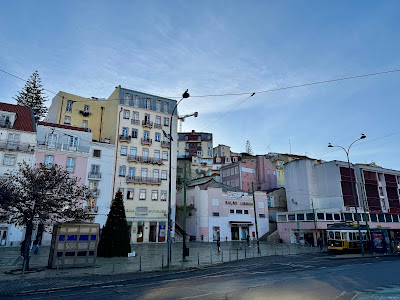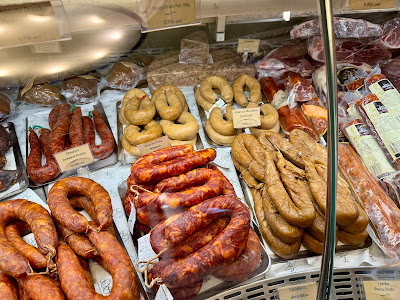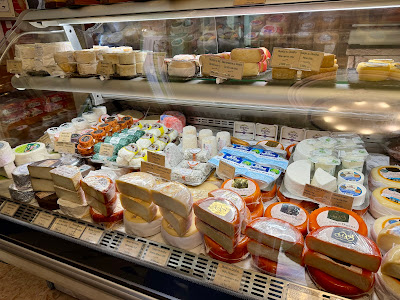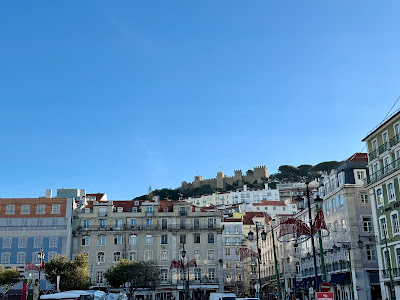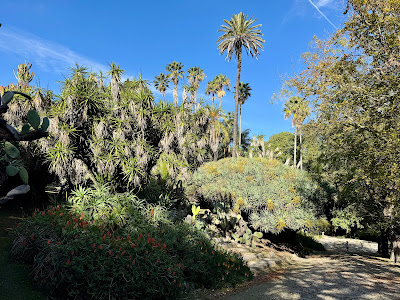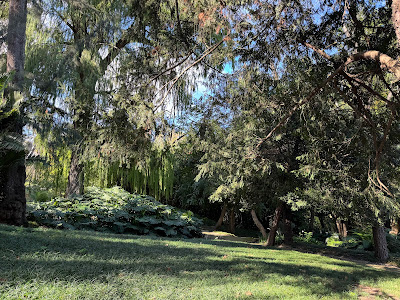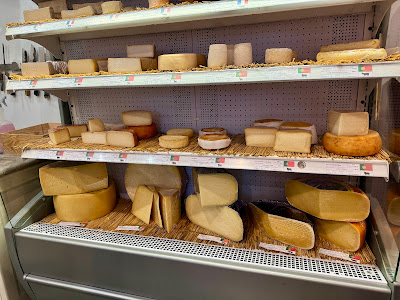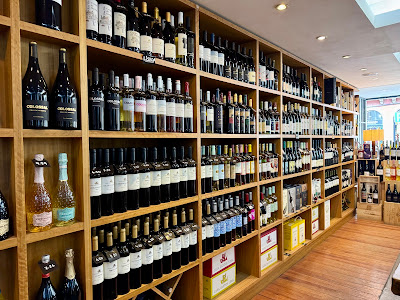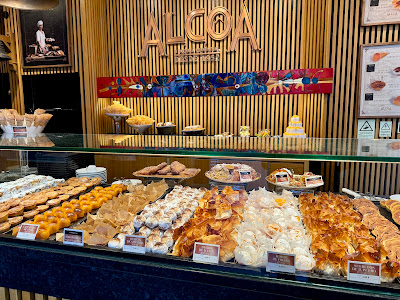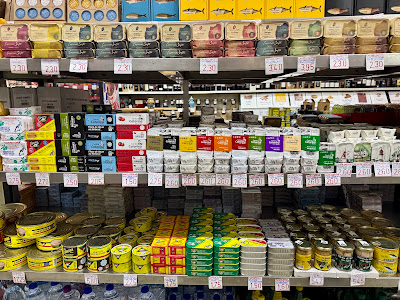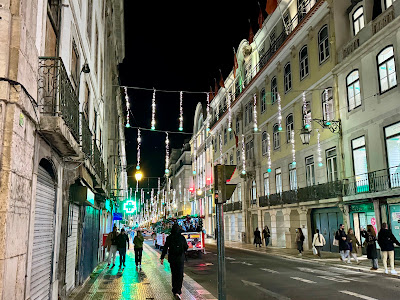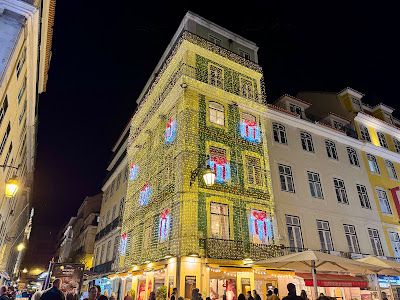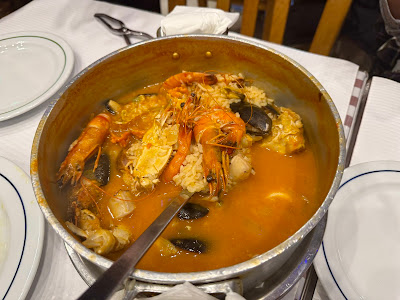Lisbon, Portugal Day 5
Day 6 was our last full day in Lisbon. We revisited As Bifanas do Afonso at 8 am to get J's dream breakfast once again. Like the last time, sliced pork was nicely simmering in the large pot and smelled wonderful! This time J got a sandwich with cheese. I'm sure J enjoyed it so much!
Next my turn. We ran by Uber to north of the city center. The destination was Pastelaria Aloma, a pastry shop founded in 1943. In Lisbon, the annual competition to select the Best Pastel de Nata has been held since 2009. 40 bakeries in the Lisbon Metropolitan Area participated in the 15th edition of the competition of 2024, and Pastelaria Aloma was the winner of the Best of Pastel de Nata. In fact, Aloma won the award in 2012, 2013 and 2015. They were in the second place in 2019, 2021 and 2022 and returned to the top 1 in 2024. I couldn't go back to Germany without tasting the latest best Nata.
The pastry shop had a small eat-in space, which was kinda crowded with people who looked like locals. Fortunately we secured a table. Orange juice for us, espresso for J, a kind of savory croquette (salted cod?) for J, and Pasteis de Nata for us. The best Nata of 2024 was my seventh Nata during the trip. It was good but the filling wasn't eggy enough for my taste. By the way, among the places I tasted a Nata during the trip, only Castro was on the 2024 participant list. Pastéis de Belém was still my Best in my own competition at that point.
We walked back to the city center, watching the north part of the city center, where we haven't been before. It was a easy walk on a little downhill and then almost flat road.
When we arrived at the city center, first we stepped in Manteigaria Silva, a historic delicatessen specialized in Portuguese cuisine, including ham and sausages, cheeses, wine and spirits, and canned and dried goods. The lady there was helpful. J chose three kinds of sausages and a kind of cheese.
The store also sells Bacalhau at the next door. Perhaps it was my first time to see and smell Portuguese salted cods that haven't been transformed into a dish. How interesting!
It has been a busy morning. We thought that it would be nice to have a little break and visited Confeitaria Nacional, founded in 1829, the oldest patisserie in downtown Lisbon. We were seated in one of the upstairs dining rooms, which was classic and comfortable.
J had Cha de Limoa, Portuguese lemon peel tea - fresh lemon peels infused in hot water. It looked simple and refreshing. He also had two kinds of small savory pastries. I don't remember what they were exactly, but one was something like a samosa and the other was croquette of shrimp and Béchamel sauce, maybe? For me, it was rare that I ordered cappuccino. J usually orders cappuccino and he did during this trip and got one topped with sweet whipped cream each time. I thought that must be Portuguese style of cappuccino and as a whipped cream lover, I wanted to have one. Well, when our waitress served me a cup of cappuccino, I was disappointed because it was topped with foamed milk. Also, I wanted to try Pão de Ló. The particular traditional Portuguese sponge cake was introduced to Japan by missionaries from Portugal in the mid 16th century. It has been called Castella in Japan and known as one of typical Japanese sweets. To taste the origin of Castella was on my must-do list of the trip. I expected Confeitaria Nacional offers Pão de Ló but I was told that they usually offer but they didn't on that day. So sad... Orange flavored sponge cake with coconuts was recommended to me as an alternative, and I had it. It was pretty good but the fact is it was not Pão de Ló!
We walked to a gourmet food store that J found online, and then surprisingly it was the same store that we visited and bought some soaps a couple of days ago. Although we remembered they didn't sell much food, we entered the store anyway. While we looked around the store again, we found a staircase that led us to more rooms in the downstairs, where variety of linens, potteries and food items were displayed! How did we miss it last time?
We picked up more canned seafoods, cookies and sea salt as well as an eggplant shaped salad bowl. All made in Portugal, of course. By the way, A Vida Portuguesa was the name of the nice store.
Then, we went to Chocolataria Equador. It's a Port-based "Bean-to-Boutique" chocolatier, currently running six stores in Portugal, including three in Port and one in Lisbon, and two in Spain. They use cacao beans from São Tomé and Príncipe, aiming to reinforce the cacao production of the African island nation in the Gulf of Guinea, which was developed when it was a colony of the Portuguese Empire but degraded after becoming independent in 1975. The aroma of the cacao grown in São Tomé and Príncipe is described as "pure chocolate, almond, tannins and wood, creating a very particular sensory profile that is unique in the world, typical of this variety and its terroir," according to the chocolatier.
From a wide range of the products, we chose two kinds of chocolate bars and four pralines. I also sampled a lemon-flavored praline there, which was excellent!
We still had a lot of times until a dinner reservation and decided to visit a botanical garden. It was located on a hill and we ended up with climbing the steep uphill of the funicular near our hotel again. I think I used up the calories from the lemony chocolate praline already.
The Miradouro de São Pedro de Alcântara was a viewpoint near the top station of the funicular. A small Christmas market was held there.
The Tagus River and the castle hill over there!
We stopped by an antique Azulejo shop on the way, which had a lot of vintage items just like a museum.
We again stopped by another chocolatier, Bettina Corallo. Although they were well-rated online, their chocolate didn't appeal me. J got a lemon flavored bar to sample and I tasted a bit. To be honest, it was too sugary for me and the texture was kinda weird. Chocolataria Equador's lemony praline was so much better.
We eventually arrived at Botanical Garden of Lisbon. The garden was created in the late 19th century by the Polytechnic School of Lisbon, which is the current Faculty of Sciences of the University of Lisbon, to support the teaching and research of botany and agriculture. Today the garden is home of over 1,400 species, including rare palms and ferns as well as endangered cycads.
The garden was spacious and quiet. I instantly forgot that I was still in the city center of Lisbon once we were covered by giant trees. We strolled around the garden and found a bench to rest and enjoy the view for a while.
Next we headed to a cheesemonger, located not so far from the garden. Queijaria is a cheese shop specialized in high quality Portuguese and International handmade cheese. The shopkeeper was friendly and very helpful. J chose three kinds of Portuguese cheese.
While we were heading back to our hotel to put cheese in the refrigerator, we happened to find a wine store. J bough a bottle of Portuguese red wine.
Then we happened to see many cans of our favorite tea brand, Mariage Frères through the window of a shop. It was a tea shop specialized in fine tea in the world. We browsed the shop and picked English Breakfast of Kusmi Tea, another French tea brand, for a change.
We climbed down the steep funicular hill this time. We never thought about riding Lisbon's famous funicular or tram...
We left the cheese at the hotel and went out for shopping again. Pastelaria Alcôa was one of my must-go pastry shops in Lisbon. They craft traditional convent sweets according to recipes from the Cistercian monks of the 13th century convents of Santa Maria de Alcobaça and Cós in the cities with the same names, Alcobaça and Cós, located over 100km north of Lisbon. To choose just some pasties out from dozens was the most difficult thing for me to do on that day, especially when everything looked delicious and I had no idea what they exactly were. The lady there was kind and explained us of what each one was made. I managed to make a box filled with seven different pastries.
They also make Pastéis de Nata. I snacked one at the small counter in the store. It was fresh, still very warm and pretty good, but didn't surpass Pastéis de Belém. I have had 8 egg custard tarts by then and Pastéis de Belém was clearly my best Nata because of its rich eggy custard filling.
We came down toward the river, passing by Lisbon City Hall.
We visited Loja das Conservas, or House of Canned Goods in English, a shop with a great amount of canned seafood, operated by the Portuguese National Association of Canned Fish Manufacturers. The shop was crowded with a film shooing crew and tourists, but we were able to get some cans. I don't have any photos of the shop... Then we happened to find a local grocery store on the same street, which had a lot of salted cod as well as a large selection of Portuguese canned seafood. We bought some more cans there.
It was getting dark and the Christmas lights in the city center looked pretty.
We had a great dinner with our friend at Uma Marisqueira, one of the restaurants that she recommended. First we had garlic shrimp as a starter, which was very nice and pretty much garlicky!
For the main dish, the restaurant only offers their famous 'Arroz de Marisco', or seafood rice. How convenience for people like me who are indecisive! You only have to choose a size: large or small. The small pot was supposed to be made for two people, which was actually large enough for three of us. It was enjoyable to share the steaming pot of several kinds of seafood, such as small and large shrimps, mussels, and crabs, and soupy rice that absorbed all the flavors of seafood, which was my favorite part. It was very tasty!
For desserts, our friend took us to a famous cafe in the Chiado district. The streets were very busy even though it was a weekday's evening.
A Brasileira was established in 1905 by Adriano Telles do Valle, a Portuguese emigrant to Brazil who married the daughter of one of the largest coffee producers there. He returned to Portugal with his wife and the coffee business in 1898. With the grand façade and luxurious interior decor, the cafe became popular, especially among lawyers, doctors, artists and writers. It has kept the plush atmosphere to date, still being popular, particurly among tourists.
Variety of pastries and cakes were arranged in the showcase. Finally I found Pão de Ló, the origin of Japanese Castella cake!
Meanwhile, I was attracted by the layered cake with whipped cream and caramel sauce. J suggested we would get both. Why not?
Pão de Ló was interesting. It was a simple eggy sponge cake with a kinda fluffy but a little bit chewy texture, which was quite different from Japanese fluffy Castella.
The caramel layer cake was wonderful. I wouldn't mind coming back to the cafe for the lovely cake.
It was a wonderful evening with fantastic dinner and dessert, cheerful Christmas lights and most importantly our friend's company. Thank you so much!!!
To be continued…









